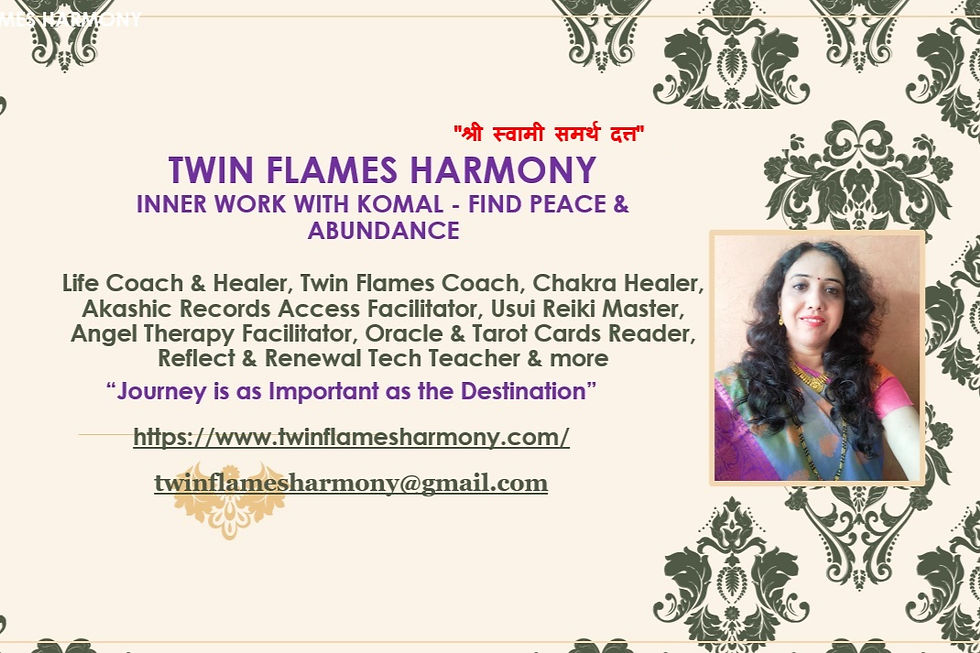Do We Need Toxic People for Spiritual Growth? Healing Without Pain Explained
- twinflamesharmony
- Aug 5
- 10 min read
Spiritual growth is often tied to pain and struggle, leading many to believe that enduring toxic relationships and experiences is essential for evolving. This pervasive idea can trap us in cycles of negativity, making us think suffering is a prerequisite for healing. But what if you could grow spiritually without pain? In this post, we’ll debunk this myth, explore the deeper psychological and spiritual truths, and offer actionable insights for your journey toward meaningful growth.
In this blog, you will explore:
The myth of “Pain = Growth” in spirituality and why it needs to be debunked
How toxic relationships can hinder rather than help your spiritual evolution
Psychological truths about emotional addiction and unresolved trauma patterns
Psychiatric insights into trauma loops, Complex PTSD, and neural healing
The spiritual trap of trigger addiction and how to break free from karmic cycles
Scriptural wisdom from the Bhagavad Gita, Upanishads, and Vedas on peaceful growth
Practical healing tools from Reiki, meditation, inner child work, and more
Emotional integration as the heart of authentic spiritual development
What to do when toxic people still appear after doing inner healing
How to anchor your growth in love, support, and self-compassion — not suffering
The Deep Misconception: “Pain = Growth”
The saying “no pain, no gain” has found its way into the realm of spirituality, suggesting that only through suffering can we realize our full potential. This idea can result in a damaging belief system where people actively seek chaos to kickstart personal growth.
However, pain does not automatically lead to spiritual evolution. In many cases, it entrenches us in old patterns, leading to recurring experiences of suffering rather than enlightenment. For instance, a study from the American Psychological Association found that individuals with a strong belief in "growth through suffering" are likely to stay in harmful relationships longer, believing they are necessary for growth.
Instead, we should recognize that growth can happen outside of pain. In fact, nurtured and peaceful environments are more conducive to genuine spiritual development. For example, many who thrive in supportive communities report feeling spiritually fulfilled without suffering through toxic dynamics.
The Psychological & Psychiatric Truth
From a psychological perspective, believing that pain equates to growth can lead to what is called "addiction to triggers." This involves an ongoing attraction to emotional turmoil, which can feel validating but ultimately hinders true healing.
When we immerse ourselves in troublesome situations or toxic relationships, we might convince ourselves we are gaining insight. In reality, we risk reinforcing a painful cycle that drags us deeper into negative patterns. A meta-analysis showed that emotional regulation and resilience play crucial roles in healing; only 30% of individuals engaged in toxic relationships reported feeling emotionally healed after leaving them.
Surrounding ourselves with supportive, healthy relationships allows for true healing and emotional integration, freeing us from the chaos that hinders progress.
The Spiritual Trap: Addiction to Triggers
Let's further explore the concept of addiction to triggers. This occurs when someone continually attracts toxic people or situations under the false belief that these experiences catalyze growth.
While initial healing may involve confronting painful past experiences, staying in these negative patterns limits progress. Continuously engaging with toxic energies sends a message to the universe that you need these types of lessons for growth.
To break free from this cycle, consciousness is key. When you recognize unhealthy patterns, you empower yourself to make better choices. For example, if you find yourself drawn to a difficult relationship, try asking: “What am I learning here? Does this chaos serve my growth?” This self-inquiry may reveal patterns about your desires and fears.

The Scriptural Truth: What Do the Shastras Say?
Ancient texts like the Bhagavad Gita, the Mandukya Upanishad, and the Yajur Veda provide timeless guidance for spiritual seekers.
Bhagavad Gita — Chapter 6, Verse 7
In the Bhagavad Gita, Chapter 6, Verse 7 emphasizes that one who conquers the mind is a true friend to themselves. This verse highlights that growth stems from inner peace and self-awareness, reinforcing the idea that suffering is not necessary for spiritual progress.
Mandukya Upanishad
The Mandukya Upanishad discusses consciousness and highlights that recognizing our true selves can lead to growth that is independent of external struggles. It teaches us that ongoing self-reflection is a pathway to real empowerment.
Yajur Veda
The Yajur Veda emphasizes the importance of peaceful relationships and inner tranquility. By concentrating on love and harmony, one can cultivate a nurturing spiritual environment that fosters genuine growth, far removed from toxic energies.
These sacred texts remind us that true spiritual growth emerges from love, awareness, and healthy connections, rather than from enduring hardship and adversity.
Divine Truth: You Are Meant to Heal in Love
Authentic spiritual growth is rooted in love, not pain. The universe encourages healing through Supportive people, kindness, and compassion. By shifting our focus inward and nurturing self-love, we attract healthier relationships and experiences.
As you cultivate acceptance of yourself and release old traumas, you create an energetic environment that invites positivity. Practices like Reiki, meditation, and inner child work can deepen your self-connection, facilitating healing. For instance, those who engage in regular meditation report a 40% improvement in emotional well-being, showcasing a clearer path toward healthy relationships.

The essence of spiritual growth lies in emotional integration—accepting all experiences, both joyful and painful, with an open heart. Instead of avoiding discomfort, we learn to embrace it with understanding.
This practice allows for growth independent of toxic relationships. By integrating all emotions, you gain insights into your patterns and can choose more empowering paths. For example, mindfulness-based practices can increase emotional awareness by 35%, improving your ability to navigate relationships more adeptly.
To encourage emotional integration, make mindfulness or meditation a routine practice. Such habits allow feelings to surface and be acknowledged without judgment, creating pathways for healing and growth.
So What Is the Right Choice?
As you continue your spiritual journey, consider: “What experiences do I want to attract? Am I ready to fully heal in love, free from toxic interactions?”
The right choice involves radical self-acceptance, focusing on love instead of suffering. Create boundaries that honor your well-being, and positively disengage from relationships that don't serve your highest self.
You have the power to redefine what growth means to you. Embrace the experiences that uplift you and allow healing to thrive within an atmosphere of love and kindness.
You’ve dedicated yourself to personal growth and intentionally welcomed only loving, respectful, and conscious individuals into your life. Yet, toxic people occasionally still appear. This can be confusing and disheartening, causing you to question your healing journey or wonder, “What am I doing wrong?” The truth is more compassionate and complex than blame or shame.
Let’s confidently explore why these residual toxic manifestations still occur, even after choosing healthier connections — through psychological, psychiatric, and spiritual lenses — and how you can transcend them.
Psychological Insight: Residual Inner Beliefs and Nervous System Conditioning
Psychologically, the relational templates formed in childhood continue to influence who we unconsciously attract. Even after consciously deciding to pursue healthy relationships, unresolved emotional imprints may still be active beneath the surface.
If your nervous system is still accustomed to chaos, conflict, or rejection, it might subtly draw you toward similar dynamics, even if your mind desires peace. Clinical psychologists refer to this as “attachment wounding replay.” Your psyche may be trying to "resolve" the past by unconsciously inviting a similar situation, hoping for a different outcome.
Tool for healing (Psychological):
Somatic therapy or trauma-informed inner child work can gently help your nervous system unlearn old patterns.
Daily journaling to track emotional triggers helps you recognize unconscious patterns.
Cognitive restructuring (from CBT) rewires beliefs like “I must earn love through suffering.”
Psychiatric Insight: Neural Pathways, Trauma Loops, and Emotional Conditioning
Psychiatrically, the brain operates through neural associations. If past trauma was linked with “love” or attention, your brain may still associate pain with connection. This can result in repetitive loops — not because you are failing, but because trauma loops need conscious interruption and neuroplasticity-based healing.
In clinical terms, this is often linked with Complex PTSD or relational trauma. Your brain isn’t betraying you — it’s simply repeating what it knows, until it learns something safer.
Tool for healing (Psychiatric):
Consult a trauma-informed psychiatrist if toxic patterns persist — EMDR (Eye Movement Desensitization and Reprocessing) or neurofeedback are scientifically proven to break trauma loops.
Use polyvagal regulation tools to calm your vagus nerve and shift your body into safety.
Take supplements or medication only under guidance if chronic anxiety or hypervigilance exists.
Spiritual Perspective: Lessons, Echoes, and Soul Contracts
From a spiritual perspective, the appearance of toxic individuals even after deep inner work may not be punishment or failure. Sometimes, these individuals appear as echoes of the past — mirrors to test if you’ll now choose differently.
In the yogic lens and the Bhagavad Gita, this is referred to as “samskara” — the residual impressions of past karma. These toxic echoes often surface when you're ready to release them completely. The presence of such people may also be part of a soul contract — not to stay in pain, but to practice detachment, discernment, and self-respect.
As Ramana Maharshi beautifully said, “Let what comes come. Let what goes go. Find out what remains.” That “what remains” is your peace, your growth, your light.
Tool for healing (Spiritual):
Practice energetic cord cutting rituals or Reiki healing to release past karmic ties.
Use mantra japa (repetition of sacred sound) to anchor your energy in the divine — for instance, “So Hum” or “Om Namo Bhagavate Vasudevaya.”
Deepen your discernment (Viveka) through meditation, self-inquiry, and sattvic living.
Integration: A Sign That Your Inner World Is Changing
When you begin to choose healthier relationships but still attract a few toxic ones, it's not a sign of failure — it's a sign of your transition. Think of it as your nervous system and karmic field detoxing the last residues of pain-based programming.
As you continue to heal, you’ll find your inner and outer worlds becoming more aligned. Your belief systems update. Your trauma loops soften. Your heart feels safer. You begin to trust peace, not chaos.
In this new vibration, love doesn’t hurt. Connection nourishes. Your energy becomes a sanctuary — not because you forced it, but because you remembered who you are.
Frequently Asked Questions (FAQs)
1. Do I need to go through pain or toxic relationships to grow spiritually?
No. While pain can sometimes act as a catalyst for awakening, it is not a requirement for spiritual growth. True transformation can happen through love, awareness, and peaceful inner work. Toxic experiences may initiate awareness, but continued suffering is not necessary to evolve.
2. Why do I keep attracting toxic people even after doing inner healing?
This could be due to unresolved subconscious patterns or nervous system conditioning. Your mind may want peace, but your body could still be familiar with chaos. As you heal deeply, these patterns begin to shift, and your outer relationships slowly reflect your inner peace.
3. Can someone grow spiritually in a peaceful, loving environment?
Absolutely. Peaceful environments often allow for deeper healing because the nervous system feels safe enough to process and integrate emotions. Love and safety create a fertile ground for real spiritual insight and growth.
4. What do the scriptures say about healing without suffering?
Texts like the Bhagavad Gita, Upanishads, and Yajur Veda speak of inner peace, self-awareness, and self-mastery as keys to liberation. They do not glorify suffering but emphasize detachment, discernment, and love as paths to union with the divine.
5. What if I’ve already been in toxic relationships—was that all meaningless?
Not at all. Every experience can carry a lesson. If you’ve gone through painful relationships, they may have revealed hidden wounds or patterns that needed attention. The key is not to stay stuck in them, but to grow beyond them with compassion for yourself.
6. How do I know if I’m spiritually progressing without chaos in my life?
Signs include emotional steadiness, clarity in decisions, healthier boundaries, compassionate relationships, and a deeper sense of inner peace. Growth shows up as a more regulated nervous system and greater self-trust—not as dramatic suffering.
7. What tools can I use to support my healing journey without repeating old pain?
Some supportive tools include inner child work, chakra balancing, guided meditation, somatic therapy, breathwork, Reiki, and mindfulness coaching. These allow healing in gentle, integrated ways without the need for external turmoil.
8. What does it mean when old patterns or toxic people still return?
Sometimes, they appear as echoes of past conditioning. It’s not a sign that you’ve failed, but that you’re ready to respond differently—with greater clarity and boundaries. It may also reflect the last stages of karmic or emotional release.
9. Is choosing peace over pain a spiritual bypass?
No. Choosing peace consciously is not bypassing—it’s wisdom. Spiritual bypassing occurs when we deny or suppress pain without understanding it. But when peace arises naturally from healed awareness, it is a genuine sign of growth.
10. Can I truly heal without revisiting all my past pain?
Yes. Not all pain needs to be relived to be released. Gentle practices can dissolve trauma from the body and mind without retraumatizing you. Healing can be compassionate, graceful, and quiet—yet profoundly deep.
Final Reflections: From My Heart to Yours
So, do we need toxic people to grow spiritually? The answer is clear: NO. Pain does not ensure growth, and toxic experiences are not essential for enlightenment.
As you embark on your healing path, let go of the belief that suffering is necessary for growth. Seek love, compassion, and awareness as the true paths for spiritual development. Surround yourself with positive energies and relationships that encourage genuine emotional integration.
Only then can you fine-tune your spiritual journey to align with your highest self.

May you walk this path with grace, courage, and an open heart.

🌸 Hi, I’m Komal Aravind 🌸
I’m a Certified Life Coach, Healer, and Spiritual Teacher. I support people through Life Coaching, Twin Flames guidance, Inner Child Healing, Chakra Balancing, Akashic Records, Reiki, Angel Therapy, and intuitive card readings.
If you're healing from the past, feeling stuck, or going through a Twin Flames journey, I'm here to walk beside you. My approach is gentle, holistic, and focused on bringing peace, clarity, and balance to every area of your life—relationships, career, finances, and spiritual growth.
✨ Feeling called to begin?
You are not alone. Your healing is sacred, and you deserve loving support.
You can explore my free and paid courses, or book a personal session
with me on my website:🌐 www.twinflamesharmony.com
📧 You’re welcome to email me at: twinflamesharmony@gmail.com
Sessions are available in Hindi or English.
With love and deep gratitude to God and all my teachers,– Komal Aravind🙏









Comments